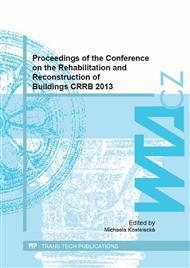[1]
ASTM D4446-08: Standard test method for anti–swelling effectiveness of water–repellent formulations and differential swelling of untreated wood when exposed to liquid water environments (2008).
DOI: 10.1520/d4446-08
Google Scholar
[2]
L. De Vetter, J. Van Acker, Accelerated L-joint performance testing of organosilicon treated wood, The International Research Group on Wood Protection, Stockholm, (2010).
Google Scholar
[3]
L. De Vetter, J. Van den Bulcke, J. Van Acker, Impact of organosilicon treatments on the wood-water relationship of solid wood, Holzforschung 64 (2010) 463-468.
DOI: 10.1515/hf.2010.069
Google Scholar
[4]
S. Donath, H. Militz, C. Mai, Creating water-repellent effects on wood by treatment with silanes, Holzforschung 60 (2006) 40-46.
DOI: 10.1515/hf.2006.008
Google Scholar
[5]
S. Donath, H. Militz, C. Mai, Treatment of wood with aminofunctional silanes for protection against wood destroying fungi., Holzforschung, 60 (2006) 210-216.
DOI: 10.1515/hf.2006.035
Google Scholar
[6]
C. A. S: Hill, Wood modification - chemical, thermal and other processes, John Wiley and Sons Ltd, Chichester, (2006).
Google Scholar
[7]
Collective of authors, Vybrané kapitoly k tématu péče o stavební a umělecké památky II. díl (Selected chapters on the topic the care of building and artistic monuments II. part), Idea servis, Praha, (2008).
Google Scholar
[8]
L. Reinprecht, L., Ochrana dreva (Protection of wood), Technical University in Zvolen, Zvolen, (2004).
Google Scholar
[9]
F. Simon, F. Marchal, F. Pochon, M. Kutnik, I. La Bayon, The potential of silicone-based formulations to enhance wood properties through industrial treatment for outdoor use, The International Research Group on Wood Protection, Stockholm, (2011).
Google Scholar
[10]
R. S. Williams, W. C. Feist, Water repellents and water repellent preservatives for wood, General Technical Report FPL 109 (1999).
DOI: 10.2737/fpl-gtr-109
Google Scholar
[11]
J. Witzany et al., PDR – Poruchy, degradace a rekonstrukce (FDR - failures, degradation, reconstruction), ČVUT, Praha, (2010).
Google Scholar
[12]
J. Žák, L. Reiprecht, Ochrana dřeva ve stavbě (Protection of wood in the building), ABF, Praha, (1998).
Google Scholar


